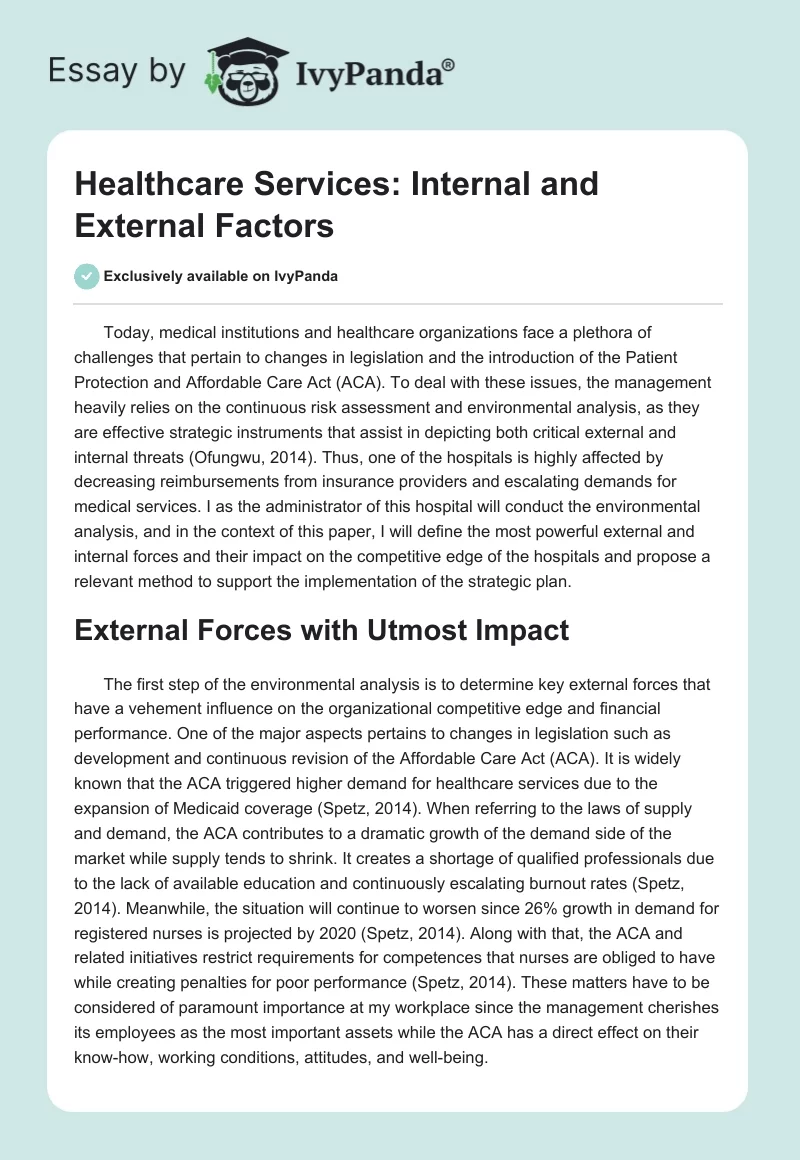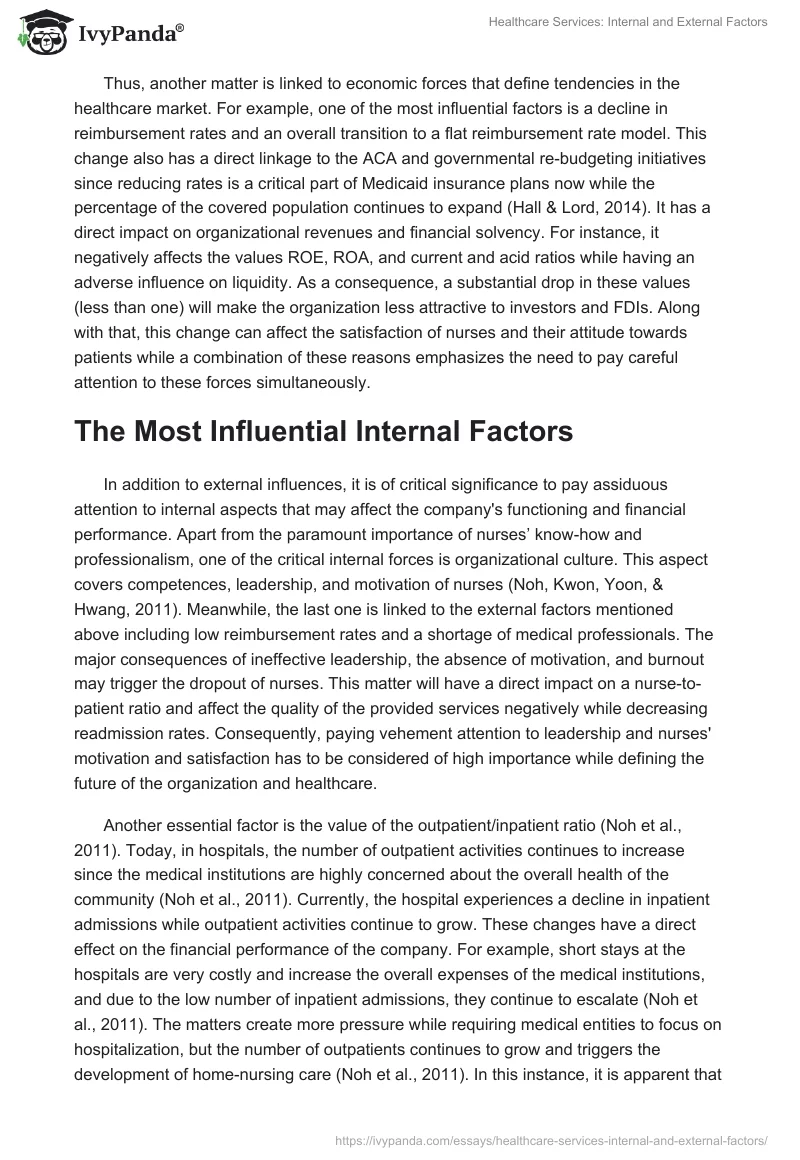Today, medical institutions and healthcare organizations face a plethora of challenges that pertain to changes in legislation and the introduction of the Patient Protection and Affordable Care Act (ACA). To deal with these issues, the management heavily relies on the continuous risk assessment and environmental analysis, as they are effective strategic instruments that assist in depicting both critical external and internal threats (Ofungwu, 2014). Thus, one of the hospitals is highly affected by decreasing reimbursements from insurance providers and escalating demands for medical services. I as the administrator of this hospital will conduct the environmental analysis, and in the context of this paper, I will define the most powerful external and internal forces and their impact on the competitive edge of the hospitals and propose a relevant method to support the implementation of the strategic plan.
External Forces with Utmost Impact
The first step of the environmental analysis is to determine key external forces that have a vehement influence on the organizational competitive edge and financial performance. One of the major aspects pertains to changes in legislation such as development and continuous revision of the Affordable Care Act (ACA). It is widely known that the ACA triggered higher demand for healthcare services due to the expansion of Medicaid coverage (Spetz, 2014). When referring to the laws of supply and demand, the ACA contributes to a dramatic growth of the demand side of the market while supply tends to shrink. It creates a shortage of qualified professionals due to the lack of available education and continuously escalating burnout rates (Spetz, 2014). Meanwhile, the situation will continue to worsen since 26% growth in demand for registered nurses is projected by 2020 (Spetz, 2014). Along with that, the ACA and related initiatives restrict requirements for competences that nurses are obliged to have while creating penalties for poor performance (Spetz, 2014). These matters have to be considered of paramount importance at my workplace since the management cherishes its employees as the most important assets while the ACA has a direct effect on their know-how, working conditions, attitudes, and well-being.
Thus, another matter is linked to economic forces that define tendencies in the healthcare market. For example, one of the most influential factors is a decline in reimbursement rates and an overall transition to a flat reimbursement rate model. This change also has a direct linkage to the ACA and governmental re-budgeting initiatives since reducing rates is a critical part of Medicaid insurance plans now while the percentage of the covered population continues to expand (Hall & Lord, 2014). It has a direct impact on organizational revenues and financial solvency. For instance, it negatively affects the values ROE, ROA, and current and acid ratios while having an adverse influence on liquidity. As a consequence, a substantial drop in these values (less than one) will make the organization less attractive to investors and FDIs. Along with that, this change can affect the satisfaction of nurses and their attitude towards patients while a combination of these reasons emphasizes the need to pay careful attention to these forces simultaneously.
The Most Influential Internal Factors
In addition to external influences, it is of critical significance to pay assiduous attention to internal aspects that may affect the company’s functioning and financial performance. Apart from the paramount importance of nurses’ know-how and professionalism, one of the critical internal forces is organizational culture. This aspect covers competences, leadership, and motivation of nurses (Noh, Kwon, Yoon, & Hwang, 2011). Meanwhile, the last one is linked to the external factors mentioned above including low reimbursement rates and a shortage of medical professionals. The major consequences of ineffective leadership, the absence of motivation, and burnout may trigger the dropout of nurses. This matter will have a direct impact on a nurse-to-patient ratio and affect the quality of the provided services negatively while decreasing readmission rates. Consequently, paying vehement attention to leadership and nurses’ motivation and satisfaction has to be considered of high importance while defining the future of the organization and healthcare.
Another essential factor is the value of the outpatient/inpatient ratio (Noh et al., 2011). Today, in hospitals, the number of outpatient activities continues to increase since the medical institutions are highly concerned about the overall health of the community (Noh et al., 2011). Currently, the hospital experiences a decline in inpatient admissions while outpatient activities continue to grow. These changes have a direct effect on the financial performance of the company. For example, short stays at the hospitals are very costly and increase the overall expenses of the medical institutions, and due to the low number of inpatient admissions, they continue to escalate (Noh et al., 2011). The matters create more pressure while requiring medical entities to focus on hospitalization, but the number of outpatients continues to grow and triggers the development of home-nursing care (Noh et al., 2011). In this instance, it is apparent that paying attention to the outpatient/inpatient ratio is of high importance, as it defines the organizational performance and determines whether it will be viable to operate in the recent future.
The Effect of Internal and External Factors on Competitive Edge
Apart from identifying external and internal forces, it is essential to determine their degree of influence on the company’s competitive edge. The previous analysis showed that internal and external factors tended to be interdependent. For example, as it was mentioned earlier, the major consequences of the ACA were associated with the shortage of nurses and the low quality of the provided care (Spetz, 2014). These factors not only have an impact on the well-being and satisfaction of nurses and patients but also affect the company’s position in the market while making it less attractive than medical entities that focus on patient-centered care.
It could be said that one cannot underestimate a correlation between these internal and external factors, competitive edge, and financial performance. It was depicted in the previous sections that decreasing reimbursement rates hurt the motivation and satisfaction of nurses while increasing the number of outpatients raised costs significantly. The ability of the company to survive in the continuously intensifying rivalry is highly dependent on these trends and its financial performance. Currently, the hospital’s financial health is not associated with the growth in a positive direction. For example, when forecasting a continuous drop in reimbursement rates, it could be said that its solvency and liquidity ratios will also decrease in their values. This matter will create obstacles for technological development and research, as the medical institutions will not be attractive to investors due to the lack of financial stability.
Along with that, current changes in the market related to reimbursement rates and coverage of the ACA trigger development of partnerships and affiliations to survive the intensified competition (Hall & Lord, 2014). This factor implies that the market will be occupied by the companies with well-developed brand images, and small firms will have to face high barriers when entering the industry or surviving on it. Another factor that has a direct impact on the competitiveness of the hospital is the attitudes of nurses. In this case, low levels of motivation accompanied by the insufficient leadership style will question the ability of the hospital to offer high-quality and patient-centered services. It will not only damage its reputation but also develop a wrong attitude towards the medical institution among potential patients. Overall, it could be said that it is vital to pay attention to both internal and external factors due to their interdependence. Nonetheless, focusing on internal forces such as motivation of nurses and organizational culture has to be discovered as a priority since these matters have a stronger impact on the competitive edge and brand image than external ones.
Strategic Recommendations
Based on the environmental analysis conducted above, it is possible to make a particular decision concerning the most appropriate strategic initiatives. In this instance, to maintain the momentum of the strategic plan, the organization should focus on ensuring the fast responsiveness of internal culture to external forces. Consequently, the main strategy is to assure that the information is up-to-date while internal culture is not only aligned with the mission statement by also supports changes and modifications triggered by the external forces.
The first step of this strategy is to conduct a continuous environmental analysis, as this procedure will be a basis for the development of realistic goals, objectives, and Key Performance Indicators (KPI) (Fleisher & Bensoussan, 2015). Using this approach will assist in keeping the data up-to-date. Along with that, the environmental analysis will depict the main threats, strengths, internal obstacles, and opportunities. Utilizing these findings as a basis will assist in making internal adjustments and ensuring that the company’s organizational culture, mission statement, and policies cater to the needs of the patients and comply with the changes in the industry. Consequently, the management has to focus on continuous risk and environmental assessment, as this framework can be considered as a defining driver to success and financial prosperity while increasing the flexibility of the company.
Nonetheless, apart from the paramount importance of external aspects, the management of the company has to devote vital attention to the internal influences, as they have a higher degree of impact on financial viability, performance, and competitive edge. In this instance, external forces can be utilized as a foundation for internal modifications and decision-making while defining the actual strategic pathway. For example, in the context of the presented organization, it will be critical to emphasize the professional development of personnel, as they define a company’s success, quality of provided services, and hospital admissions. In turn, introducing strategic adjustments to maintain with the fluctuations of the outpatient/inpatient ratio will also help the management accomplish strategic momentum, as disregarding it will lead to financial problems, low investment in technological development and research, and, as a consequence, absence of the distinct competitive advantage. Overall, it could be said that relying on this strategy majorly implies taking advantage of emerging trends and integrating them into the existent mission, as it is the only way to stay competitive in the market and maintain the established strategic momentum.
References
Fleisher, C., & Bensoussan, B. (2015). Business and competitive analysis: Effective application of new and classic methods. Upper Saddle River, NJ: Financial Times Press.
Hall, M., & Lord, R. (2014). Obamacare: What the Affordable Care Act means for patients and physicians. British Medical Journal, 349(1), 5376-5386.
Noh, J., Kwon, Y., Yoon, S., & Hwang, J. (2011). Internal and external environmental factors affecting the performance of hospital-based home nursing care. International Nursing Review, 58(2), 263-269.
Ofungwu, J. (2014). Statistical applications for environmental analysis and risk assessment. Hoboken, NJ: John Wiley & Sons.
Spetz, J. (2014). How will health reform will affect demand for RNs. Economics of Health Care and Nursing, 32(1), 42-44.


